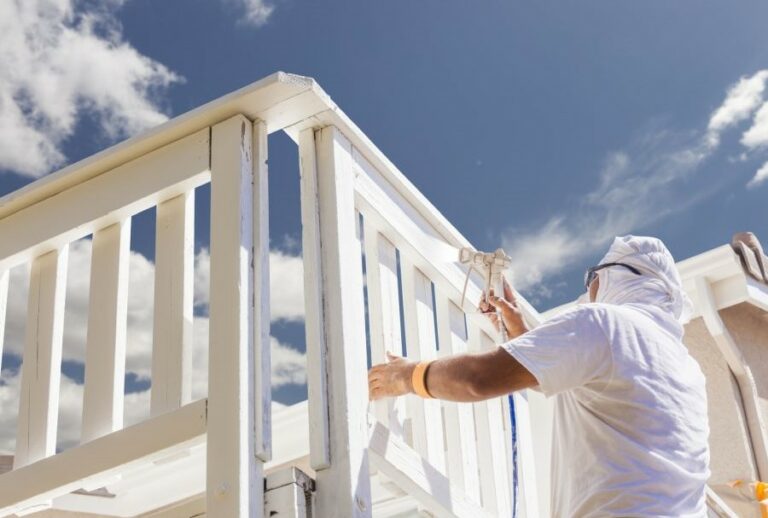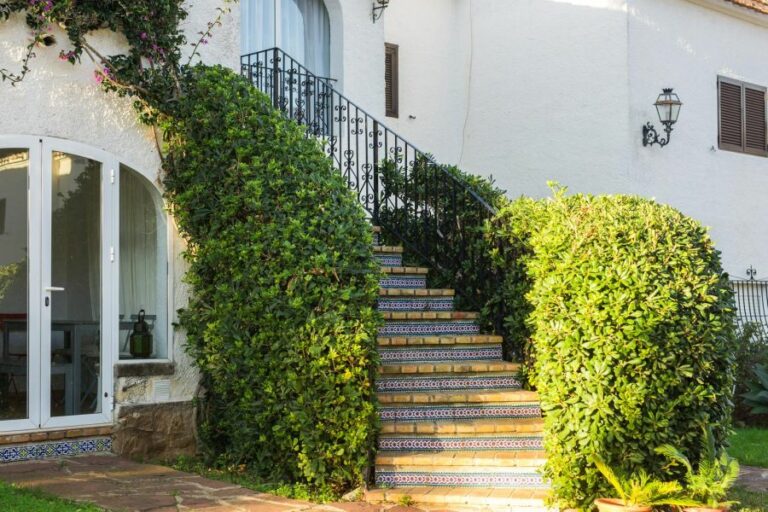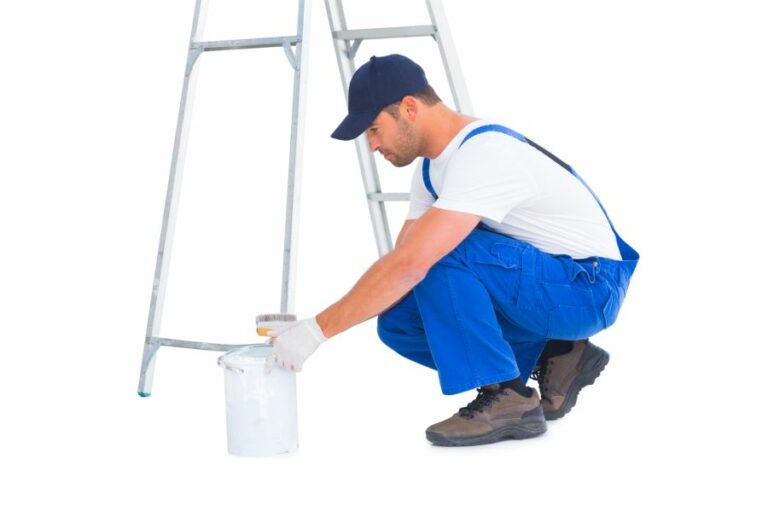Outdoor Concrete Epoxy Paint, 25 Things You Should Know
Are you tired of looking at your backyard’s dull, uninspiring concrete surface? It’s time to turn it into a stunning, easy-to-clean area that you’ll be proud to show off to friends and family! Outdoor concrete epoxy paint is your solution, and we’re here to guide you through everything you need to know.
Outdoor concrete epoxy paint:
Outdoor concrete epoxy paint is a two-component resin system that creates a hard, durable, and abrasion-resistant coating for concrete surfaces. It enhances the appearance of the concrete and provides resistance to chemicals, UV rays, and abrasion. Epoxy paint is suitable for various surfaces, including driveways, walkways, patios, and pool decks, offering benefits such as durability, aesthetics, easy maintenance, slip resistance, and waterproofing.

Want to transform your outdoor concrete surfaces into attractive, durable, and easily maintainable spaces? We’ve got you covered! Keep reading to learn about outdoor concrete epoxy paint and how it can breathe new life into your property.
Contents
- 1 Exterior Concrete Epoxy Coating Solution
- 2 Is it Possible to Apply Epoxy Paint on Outdoor Concrete Surfaces?
- 3 Is it Possible to Apply Epoxy on an Outdoor Concrete Patio?
- 4 Which is the superior choice for a concrete patio: paint or epoxy?
- 5 What is the Durability and Lifespan of Epoxy Paint on Concrete Surfaces?
- 6 Evaluating the Suitability of Epoxy Paint for Concrete Applications
- 7 What is the Most Effective Protective Coating for Outdoor Concrete Surfaces?
Exterior Concrete Epoxy Coating Solution
Concrete surfaces, both indoor and outdoor, are subject to wear and tear over time. Harsh weather conditions, heavy foot traffic, or chemical spillage can cause the concrete to chip, crack or fade.
To maintain the longevity and appearance of your outdoor concrete surfaces, you should consider using outdoor concrete epoxy paint, which provides a strong and durable protective coating.
• What is Outdoor Concrete Epoxy Paint?
Outdoor concrete epoxy paint is a two-component resin system that forms a hard, durable, and abrasion-resistant coating for concrete surfaces.
It creates a smooth, high-gloss finish that not only enhances the appearance of the concrete but also provides resistance to chemicals, UV rays, and abrasion.
Epoxy paint is designed for outdoor use and is suitable for various surfaces, such as driveways, walkways, patios, and pool decks.
• Why Choose Outdoor Concrete Epoxy Paint?
There are several reasons to choose epoxy paint for your outdoor concrete surfaces. Some of the key benefits include:
– Durability
Epoxy paint creates a tough, long-lasting barrier that withstands various weather conditions, heavy traffic, and chemical exposure. It resists chipping, cracking, and fading, ensuring that your concrete surface remains in good condition for an extended period.
– Aesthetics
Outdoor concrete epoxy paint comes in a wide range of colors and finishes, allowing you to customize the appearance of your concrete surface according to your preferences. Its glossy finish also enhances the overall look of the concrete, making it visually appealing.
– Easy Maintenance
Epoxy-coated surfaces are easy to clean and maintain as they resist stains and dirt buildup. All you need is a broom or a mop to keep your concrete surface looking new and fresh.
– Slip Resistance
Safety is paramount, especially in outdoor spaces where water and moisture may create slick surfaces. Outdoor concrete epoxy paint can be combined with anti-slip additives to create a textured surface that reduces the risk of slips and falls.
– Waterproofing
Epoxy paint forms a seamless, waterproof barrier that prevents water penetration, reducing the risk of mold and mildew growth. This is particularly beneficial in areas with heavy rainfall or where water tends to pool.
• How to Apply Outdoor Concrete Epoxy Paint
Before applying outdoor concrete epoxy paint, it is essential to ensure proper surface preparation. Here are the steps to follow:
– Step 1: Clean the Concrete Surface
Remove any dirt, dust, or debris from the surface using a broom or a pressure washer.
– Step 2: Repair Cracks and Holes
Inspect the surface for cracks and holes, and repair them using a concrete repair compound. Allow it to cure as per the manufacturer’s instructions.
– Step 3: Etch the Concrete Surface
Etching the concrete surface is crucial for epoxy paint adhesion. You can use a commercial etching solution, following the recommended dilution rates and application instructions.
– Step 4: Mix the Epoxy Paint Components
Epoxy paint typically comes in two separate components – the resin (Part A) and the hardener (Part B). Mix the two parts together in a separate container using the manufacturer’s recommended ratio.
– Step 5: Apply the Epoxy Paint
Using a brush or roller, apply the epoxy paint evenly over the concrete surface. If you want to use a non-slip additive, mix it with the epoxy paint or sprinkle it on the surface immediately after painting.
– Step 6: Allow to Dry and Cure
Allow the epoxy paint to dry and cure according to the manufacturer’s instructions. Usually, a minimum of 24 hours is needed for the epoxy to cure fully.
• Ensuring a Successful Epoxy Coating Application
To ensure the best results, consider the following tips when applying outdoor concrete epoxy paint:
– Weather Conditions
Avoid applying epoxy paint in extreme temperatures or high humidity levels, as this can affect the curing process and overall performance.
– Primer Application
Applying a primer before applying outdoor epoxy paint can enhance the adhesion and prolong the life of the paint.
– Thickness of Coating
Ensure you apply outdoor epoxy paint at the recommended thickness. Too thin coats might not provide sufficient protection, while excessively thick coats can lead to uneven curing.
– Ventilation
If you are applying epoxy paint in an enclosed outdoor space, ensure proper ventilation to avoid inhaling toxic fumes.
• Conclusion
Outdoor concrete epoxy paint is an excellent solution for protecting and enhancing the appearance of your outdoor concrete surfaces. By carefully following the application steps and considering the tips mentioned above, you can achieve a durable, long-lasting, and attractive concrete surface.
For further information and assistance, refer to industry resources and expert guides, such as the American Concrete Institute or your local concrete professionals.
Is it Possible to Apply Epoxy Paint on Outdoor Concrete Surfaces?
Epoxy paint is a popular choice for covering and protecting a variety of surfaces, including outdoor concrete. Its durability, resistance to chemicals and water, and aesthetic appeal make it an attractive option for many homeowners and commercial property owners.
• Benefits of Using Epoxy Paint on Outdoor Concrete
Epoxy paint offers several advantages for outdoor concrete surfaces. Some of the key benefits include:
– Durability
Epoxy coatings are known for their exceptional durability, which makes them ideal for outdoor concrete surfaces that are subjected to heavy foot traffic, UV exposure, and weather changes.
The cured epoxy paint forms a tough, hard surface that is resistant to abrasion and impact, ensuring the longevity of the concrete surface.
– Water and Chemical Resistance
Epoxy paint creates a waterproof barrier that protects the concrete from water penetration, chemicals, and stains. This makes it an ideal choice for outdoor concrete areas near swimming pools, driveways where vehicles may leak fluids, or patios where spills and stains are common.
– Aesthetic Appeal
Available in a wide range of colors and finishes, epoxy paint can dramatically improve the appearance of an outdoor concrete surface. The glossy, seamless finish adds a modern and clean look to any space, and the paint can also be combined with decorative chips or flakes for added visual interest.
– Easy Maintenance
Epoxy-coated surfaces are easy to clean, as they are nonporous and do not absorb dirt, grease, or spills. A simple hose down or sweep is usually enough to keep the surface looking fresh and clean.
• Limitations of Using Epoxy Paint on Outdoor Concrete
Despite its many benefits, there are some limitations to be aware of when considering epoxy paint for outdoor concrete surfaces:
– UV Exposure
Prolonged exposure to UV rays can cause epoxy paint to turn yellow or fade over time. To avoid this issue, it is essential to choose a UV-resistant epoxy product specifically designed for outdoor use.
– Uneven Surfaces
Epoxy paint may not adhere properly to uneven or cracked concrete surfaces, which can result in the coating peeling or chipping. Before applying epoxy paint, it is crucial to repair any significant cracks or imperfections in the concrete.
– Temperature and Humidity
Epoxy paint is sensitive to temperature and humidity during its application and curing process. It is essential to follow the manufacturer’s guidelines for the ideal temperature and humidity levels in your area when applying epoxy paint.
• Application Process
To achieve the best results when using epoxy paint on outdoor concrete surfaces, it is essential to follow these steps:
– Step 1: Prep the Surface
Before applying epoxy paint, prepare the concrete surface by cleaning, removing any loose or flaking paint, and repairing any cracks, pits, or other imperfections. It may be necessary to etch the surface with a mild acid solution to ensure proper adhesion.
– Step 2: Prime the Surface
Once the surface is clean and prepped, it is essential to apply a quality epoxy primer, which will help to ensure better adhesion and enhance the durability of the final epoxy coating.
– Step 3: Mix the Epoxy Paint
Epoxy paint typically comes in two parts – a resin and a hardener – which need to be mixed according to the manufacturer’s directions. Be sure to mix the components thoroughly and allow them to sit for the recommended “induction time” before application.
– Step 4: Apply the Epoxy Paint
Using a roller, brush, or sprayer, apply the epoxy paint in thin, even coats, ensuring full coverage of the surface. Be sure to wait the recommended time between coats, as specified by the manufacturer.
– Step 5: Allow to Cure
Once the final coat of epoxy paint has been applied, allow the surface to cure fully before using it. Curing times may vary depending on the product and environmental conditions, so follow the manufacturer’s recommendations.
• Maintenance Tips
To keep your epoxy-coated outdoor concrete surface in peak condition, follow these maintenance tips:
- Clean any spills or stains immediately to prevent damage to the epoxy coating.
- Sweep or hose down the surface regularly to remove dirt, debris, and other contaminants.
- Avoid using harsh chemicals, abrasives, or pressure washers, which could damage the epoxy coating.
- Inspect the surface periodically for any signs of wear or damage, such as peeling, chipping, or discoloration, and address these issues promptly to prevent further deterioration.
In conclusion, epoxy paint can be an excellent choice for protecting and beautifying outdoor concrete surfaces. However, to achieve the best results, it is essential to select a suitable product, prepare the surface correctly, and follow the proper application and maintenance guidelines.
By doing so, you can enjoy a durable, attractive, and easy-to-care-for outdoor concrete space.
Question | Answer |
|---|---|
Can you use epoxy paint on outdoor concrete? | Yes, epoxy paint can be used on outdoor concrete surfaces, as it provides durability, resistance to harsh weather conditions, and a protective layer against chemicals and moisture. |
Is it Possible to Apply Epoxy on an Outdoor Concrete Patio?
• Understanding Epoxy Coatings for Outdoor Patios
Epoxy coatings are known for their excellent durability, strength, and long-lasting protection, making them an attractive option for various applications.
When it comes to outdoor concrete patios, epoxy coatings can increase the lifespan of the space while providing a polished and aesthetically pleasing appearance.
Before diving into the specifics of applying epoxy on an outdoor concrete patio, it’s crucial to understand what epoxy coatings are, their benefits, and their potential drawbacks.
Epoxy coatings are made of two primary components, epoxy resin and hardener, which, when combined, create a strong chemical bond and become an incredibly hard, durable material. This makes epoxy an excellent choice for protecting concrete surfaces from damage and wear, especially in high-traffic areas.
– Benefits of Using Epoxy on an Outdoor Concrete Patio
- Durability: Epoxy coatings create a tough protective layer that resists wear, tear, and damage from various elements, extending the concrete patio’s lifespan.
- Low Maintenance: Once the epoxy is applied, it’s easy to clean and maintain. A simple sweep, occasional wash, or pressure wash is all you need to keep the patio looking fresh and clean.
- Weather Resistance: Epoxy is resistant to various weather conditions, including sun, rain, snow, and even freezing temperatures. This makes it suitable for outdoor use in many climates.
- Attractive Finish: Epoxy is available in various colors, patterns, and finishes, allowing for customization and achieving a professional, polished look.
- Slip-resistant: While epoxy coatings can be slippery when wet, additives can be mixed in to create a slip-resistant surface, making it safer for outdoor use.
– Drawbacks of Epoxy Coatings for Outdoor Patios
- UV Sensitivity: Epoxy coatings can be susceptible to UV degradation, causing discoloration or a chalky appearance when exposed to direct sunlight over time. To prevent this, a UV-resistant topcoat or sealant can be applied.
- Temperature Sensitivity: Epoxy may not cure well in extreme temperatures or temperature fluctuations, which may affect the final result. It’s crucial to apply epoxy when temperatures are within the manufacturer’s recommended range.
• How to Apply Epoxy on an Outdoor Concrete Patio
– Step 1: Prepare the Surface
Proper surface preparation is essential to ensure a strong bond between the epoxy coating and the concrete. The concrete should be free of dirt, debris, oil, or any contaminants. Clean the surface thoroughly with a pressure washer or perform a deep clean using a concrete cleaner and scrubber.
If there are any cracks or damages, repair them with a concrete patch or filler. Once the surface is clean and dry, the concrete may need to be etched or ground to create a suitable profile for epoxy adhesion.
This can be done using an etching solution or a diamond grinder, depending on the condition of the surface.
– Step 2: Choose the Right Epoxy for the Job
There are different types of epoxy coatings available, and selecting the right one for your patio location, climate, and desired aesthetic is crucial. Some epoxy coatings are specifically designed for outdoor use and have UV resistance.
Make sure to follow the manufacturer’s recommendations, and don’t hesitate to consult a professional to make the best choice.
– Step 3: Mix the Epoxy Resin and Hardener
Following the instructions provided by the epoxy manufacturer, mix the epoxy resin and hardener in the correct ratio using a mechanical mixer or a drill with a mixing paddle attachment. Ensure that the components are mixed thoroughly to create the proper chemical reaction.
– Step 4: Apply the Epoxy Coating
Using a roller or brush, apply the epoxy coating to the surface of the patio in a thin, even layer. Some epoxy systems may require multiple layers, and each layer will typically need 8-12 hours to cure or dry.
Be sure to consult the manufacturer’s directions for the recommended number of layers, dry times, and any recoating windows.
– Step 5: Add a UV-resistant Topcoat or Sealant (Optional)
As mentioned earlier, UV exposure may cause the epoxy to discolor or degrade over time. To ensure the longevity and appearance of your epoxy-coated patio, consider applying a UV-resistant topcoat or sealant. This will also provide added protection and enhancement of the surface.
• Conclusion
Applying an epoxy coating to an outdoor concrete patio offers many benefits, including durability, low maintenance, weather resistance, and an attractive finish. However, it is crucial to choose the right epoxy coating, properly prepare the surface, and apply the epoxy under ideal conditions.
By taking these factors into consideration, your patio will be a stunning and durable outdoor space that can be enjoyed for years to come.
For more information on concrete and epoxy technology, the Portland Cement Association offers a wealth of resources on its website.
Question | Answer |
|---|---|
Can you epoxy an outdoor concrete patio? | Yes, you can apply epoxy on an outdoor concrete patio, but it’s essential to choose a UV-resistant epoxy coating to prevent yellowing and chalking due to sun exposure. Proper surface preparation and application, according to the manufacturer’s instructions, are also critical for a long-lasting epoxy finish. |
Which is the superior choice for a concrete patio: paint or epoxy?
Deciding between paint and epoxy for your concrete patio is an important decision. Both options have their merits, and understanding the specifics of each can help you make an informed choice.
• Benefits of Paint for Concrete Patio
– Cost-Effective Solution
One of the most significant advantages of using paint for your concrete patio is affordability. Paint is generally less expensive than epoxy and is widely accessible. It can be a cost-effective solution for those on a tight budget or those intending to renovate their patio in the near future.
– Easy Application
Painting a concrete patio is a relatively straightforward process that can easily be done by homeowners with minimal experience. Additionally, paint typically dries faster than epoxy, allowing you to use your patio sooner after application.
– Variety of Colors and Textures
When choosing paint, you will have a plethora of options in terms of color and texture. This wide variety allows you to customize the appearance of your concrete patio to suit your preferences and match your home’s aesthetics.
• Drawbacks of Paint for Concrete Patio
– Durability Concerns
Paint is generally less durable than epoxy coatings. This means that it is more susceptible to chipping, peeling, and fading over time, particularly in areas with high foot traffic, heavy furniture, or frequent exposure to the elements.
– Maintenance Requirements
Painted concrete patios tend to require more frequent maintenance, such as repainting or resealing, to maintain their appearance and prevent damage from the elements. This can be time-consuming and costly in the long run.
– Moisture Resistance
Painted surfaces do not typically offer the same level of moisture resistance as epoxy coatings, making them more susceptible to damage from water and humidity. This could lead to mold or mildew issues, especially in damp climates.
• Benefits of Epoxy for Concrete Patio
– Long-lasting and Durable
Epoxy is a robust and durable material that can withstand heavy foot traffic, extreme weather conditions, and many other outdoor wear factors. This durability makes it ideal for concrete patios that must endure repeated use, temperature fluctuations, and precipitation.
– Resistant to Stains and Scratches
Epoxy coatings are highly resistant to stains, making them suitable for use on concrete patios exposed to spills, such as those near outdoor grilling or dining areas. They also provide a hard surface that can resist scratches and scuff marks, contributing to their overall durability.
– Moisture Resistance
Epoxy coatings are known for their ability to repel water, preventing damage from moisture and humidity. This attribute makes them well-suited for use in damp climates or areas prone to standing water, such as near pool decks or garden areas.
• Drawbacks of Epoxy for Concrete Patio
– Expense
Epoxy coatings tend to be more expensive than paint, which may be a determining factor for homeowners on a budget. The application process can also be more complex and time-consuming, which could increase labor costs if hiring a professional.
– Difficult to Remove
If you decide to change the appearance of your concrete patio at some point in the future, removing epoxy can be challenging and labor-intensive. This factor may impact your decision to choose an epoxy coating, especially if you anticipate future changes to your patio’s design.
• Making the Best Choice for Your Concrete Patio
Based on the benefits and drawbacks of each material, it is easier to make an informed decision on the best choice for your concrete patio. In summary:
- Choose paint for your concrete patio if you want a cost-effective solution, easy application, and a wide variety of colors and textures.
- Choose epoxy for your concrete patio if you want a highly durable, long-lasting, and moisture-resistant surface.
As a final recommendation, consider your patio’s specific needs, your budget, and your desired aesthetic appearance when choosing between paint and epoxy. Ensuring that you take all factors into account will help you make the best decision for your concrete patio while achieving satisfactory results.
What is the Durability and Lifespan of Epoxy Paint on Concrete Surfaces?
Epoxy paint is a popular choice for painting concrete surfaces due to its durability, resistance to chemicals and water, and overall attractive appearance. However, a common question arises: how long does epoxy paint last on concrete?
• The Lifespan of Epoxy Paint on Concrete
The lifespan of epoxy paint on concrete depends on several factors, such as the quality of the epoxy, proper installation, environmental conditions, and maintenance. High-quality epoxy coatings can last anywhere from 5 to 15 years, with some even going beyond 20 years.
However, in conditions where heavy traffic, intense UV exposure, and frequent exposure to chemicals are present, the lifespan may be reduced.
– Epoxy Quality
The quality of the epoxy paint plays a significant role in its durability. Industrial-grade epoxy paints, for instance, are built to withstand heavy wear and tear and have a longer lifespan than basic or residential-grade epoxy coatings.
They are also typically more resistant to chemicals and moisture, further extending their longevity.
– Proper Installation
Ensuring that the epoxy paint is properly applied is vital in determining its lifespan. This includes surface preparation and following the manufacturer’s instructions and suggested curing times.
A well-prepared surface for painting will allow the epoxy to bond better with the concrete, reducing the risk of peeling or flaking over time. Proper curing time will enable the epoxy coating to reach its maximum potential in terms of durability.
– Environmental Conditions
In outdoor settings and areas exposed to substantial UV radiation or temperature fluctuations, epoxy paint may deteriorate faster than in controlled environments.
The protective topcoat or sealer, often applied along with epoxy paint, can help combat these conditions, but prolonged exposure to harsh elements may still reduce the overall lifespan of the epoxy coating on concrete.
– Maintenance
Regular maintenance will enable you to keep your epoxy-coated concrete surface in top condition and ensure its longevity. This includes routine cleaning, addressing any signs of wear and tear, and resealing the surface when necessary.
• Tips for Maximizing the Lifespan of Epoxy Paint on Concrete
To ensure that your epoxy paint on concrete lasts as long as possible, follow these best practices for maintaining the surface:
– Routine Cleaning
Keeping the concrete surface clean is essential to prevent staining and the buildup of dirt and grime, which can wear down the epoxy coating. Sweep the surface regularly and avoid using harsh chemicals or abrasive cleaning tools, which can damage the epoxy.
Using a soft-bristled broom or mop with a mixture of water and a mild soap is often effective for cleaning epoxy-coated concrete floors.
– Addressing Chips, Cracks, and Peeling
Over time, the epoxy coating may experience chips, cracks, or peeling due to heavy wear and tear, particularly in high-traffic areas or in environments where heavy objects are frequently moved.
Address these issues promptly by repairing the damaged area or applying a new coat of epoxy paint to seal the damage and prevent it from worsening.
– Resealing the Surface
To protect the epoxy paint from UV exposure and other environmental elements, a protective sealer or topcoat may be applied. It is essential to reapply the sealer as per the manufacturer’s recommendations, which can vary from every two to five years.
The resealing process will help maintain the integrity of the epoxy coating and prolong its lifespan.
– Avoiding Moisture and Chemical Exposure
While epoxy paint is generally resistant to moisture and chemicals, prolonged or extreme exposure can eventually wear down the surface. To ensure the longevity of the epoxy coating, take necessary precautions to minimize water and chemical exposure.
For example, avoid using too much water when cleaning the surface, and clean up any chemical spills as soon as possible.
• Conclusion
The lifespan of epoxy paint on concrete depends on factors such as the quality of epoxy used, proper installation, environmental conditions, and maintenance. With proper care and maintenance, a high-quality epoxy coating can last anywhere between 5 to 15 years or even longer.
Following the best practices mentioned above can help maximize the durability and lifespan of your epoxy-coated concrete surface, providing you with a long-lasting, attractive, and functional surface.
For more information about epoxy paints and concrete surfaces, you can refer to resources provided by credible institutions, such as the Portland Cement Association. Additionally, consulting professionals in the field can provide more tailored advice and help you choose the right epoxy paint for your specific needs.
Factors | Expected Lifetime |
|---|---|
Indoor residential usage | 10-30 years |
Indoor commercial or industrial usage | 5-10 years |
Outdoor usage | 2-5 years |
High-traffic areas | 3-7 years |
Low-traffic areas | 10-15 years |
Evaluating the Suitability of Epoxy Paint for Concrete Applications
Epoxy paint is a popular choice for coating concrete surfaces, offering a range of benefits for both appearance and protection.
• Advantages of Epoxy Paint for Concrete
– Durability and Longevity
One of the primary benefits of epoxy paint for concrete is its exceptional durability. Epoxy paint forms a strong, resistant layer on the surface of the concrete, protecting it from damage caused by foot traffic, impact, or chemicals.
This resistance translates to a longer-lasting finish and less frequent need for repainting or touch-ups.
– High Resistance to Chemicals
Epoxy paint is highly resistant to a wide range of chemicals, making it an ideal choice for concrete surfaces in environments where chemical exposure is likely. This resistance means the paint can withstand common household or industrial chemicals without degrading or becoming discolored.
– Improved Appearance
Epoxy paint provides a glossy, professional-looking finish to concrete surfaces. Available in a wide array of colors, it allows for customization and can dramatically improve the appearance of a space.
Additionally, epoxy paints can also be mixed with decorative chips or aggregates, further enhancing the visual appeal of the concrete.
– Enhanced Safety
Safety is an important consideration when selecting paint for concrete, particularly in environments where traction is critical. Many epoxy paints are available with added anti-slip aggregates, creating a safer surface that can help prevent slips and falls.
– Low Maintenance
Epoxy paint forms a non-porous, seamless surface on the concrete, making cleaning and maintenance much easier. The surface can be swept, mopped, or wiped down with minimal effort, and the paint’s resistance to chemicals means that even harsh cleaners will not damage the finish.
• Potential Drawbacks of Epoxy Paint for Concrete
– Surface Preparation
Epoxy paint requires thorough surface preparation to ensure proper adhesion to the concrete. This process typically involves cleaning, repairing any cracks or damage, and potentially grinding or acid-etching the concrete to create a suitable surface profile.
Failing to properly prepare the surface can result in poor adhesion and a less durable finish.
– Application Process
Applying epoxy paint to concrete can be a time-consuming and labor-intensive process. The paint is typically applied in multiple coats, each requiring time to cure before the next can be added. Additionally, epoxy paints must be mixed correctly to ensure a consistent and durable finish.
– Potential for Bubbling
While rare, epoxy paint can sometimes form bubbles on the surface of the concrete when applied. This is generally caused by outgassing from the concrete substrate or from moisture trapped in the slab. Proper surface preparation and choosing a breathable epoxy paint can help prevent this issue.
– Cost
Epoxy paint is generally more expensive than other types of concrete coatings, such as acrylic or latex paints. However, considering the durability and protective qualities of epoxy paint, the investment can often be well worth it in the long run.
• Recommendations for Applying Epoxy Paint to Concrete
- Properly prepare the surface: Cleaning and repairing the concrete and, if necessary, grinding or etching the surface are key steps in ensuring a successful epoxy paint application.
- Choose a high-quality epoxy paint: The durability and performance of your epoxy paint largely depend on the quality of the product you select. Choose a reputable manufacturer and read product reviews before purchasing.
- Allow ample drying and curing time: Epoxy paint takes time to cure and harden. Be sure to follow the manufacturer’s recommendations regarding drying and curing times to guarantee a durable, long-lasting finish.
- Take care with the application: Applying epoxy paint can be tricky, so be sure to follow the manufacturer’s guidelines for the application process. If you’re unsure of your ability to achieve a professional finish, consider hiring an experienced epoxy paint contractor.
- Consider moisture control: If you’re applying epoxy paint to a concrete surface that’s prone to moisture, choose a breathable epoxy paint to help prevent bubbling and delamination.
• Conclusion
Epoxy paint offers many advantages for concrete surfaces, including durability, chemical resistance, improved appearance, and low maintenance. However, proper surface preparation and application are crucial to ensuring a successful, long-lasting finish.
By carefully considering these factors, you’ll be well-equipped to decide if epoxy paint is the right choice for your concrete project. For further information on epoxy paint and its applications, consult resources such as the American Concrete Institute or the Epoxy Resin Committee.
What is the Most Effective Protective Coating for Outdoor Concrete Surfaces?
Protecting outdoor concrete surfaces is essential in ensuring a long-lasting and attractive appearance. Choosing the right coating can be challenging, but understanding the factors that determine the best concrete coating will make your decision easier.
• Understanding the Purpose of Concrete Coatings
Coatings serve multiple purposes, including protection against weather, moisture, chemicals, and wear and tear. The choice of coating depends on the specific needs and requirements of your outdoor concrete surface.
– Protection from Weather and Environmental Factors
Outdoor concrete surfaces must withstand exposure to sunlight, rain, temperature fluctuations, and other environmental factors. Therefore, the ideal coating should offer excellent resistance to ultraviolet (UV) rays, water, and temperature changes.
– Resistance to Chemicals and Stains
In addition to being able to resist environmental factors, the best concrete coating should offer protection against chemicals and stains. This factor is especially important in cases where the surface may be exposed to oil, gasoline, or other chemicals.
– Wear and Tear
Lastly, outdoor concrete surfaces are often subject to heavy foot and vehicle traffic. A well-chosen concrete coating should offer resistance to abrasion, which will ensure durability and longevity.
• The Types of Concrete Coatings and their Characteristics
There are several types of concrete coatings available, each with its strengths and weaknesses. The best coating for your outdoor concrete surface will depend on the specific situation and requirements. Based on durability, resistance, and overall performance, here are some of the best concrete coatings:
– Acrylic Sealers
Acrylic sealers are a popular choice for outdoor concrete surfaces due to their UV resistance, water repellency, and stain resistance. They can be applied as a clear coat or in various colors to provide a decorative touch. Additionally, acrylic sealers are relatively easy to apply and quick-drying.
The American Concrete Institute recommends using acrylic sealers for exterior concrete surfaces where impermeability and superior UV resistance are required.
Recommendations:
- I recommend using solvent-based acrylic sealers for greater resistance to moisture and chemicals compared to their water-based counterparts.
- Ensure proper surface preparation and follow the manufacturer’s guidelines for the best results and longevity.
– Epoxy Coatings
When it comes to resistance against chemicals, epoxies are an excellent choice. They provide a robust and durable coating that can withstand heavy foot and vehicle traffic. However, epoxy coatings are not ideal for outdoor use due to their tendency to yellow and degrade under UV light exposure.
In cases where UV resistance is not paramount, epoxy coatings are a suitable option for outdoor concrete surfaces with high chemical exposure.
Recommendations:
- If you opt for epoxy coatings, select a high-quality product with good UV protection to minimize surface degradation.
- Ensure excellent surface preparation before application to achieve the best results and durability.
– Polyurethane Coatings
Polyurethane coatings offer high resistance to UV damage, wear and tear, and chemicals, making them an ideal choice for outdoor concrete surfaces. These coatings also offer flexibility, which helps them resist cracking and chipping.
However, polyurethane coatings can be more challenging to apply compared to other coatings, and they may require more time to cure.
Recommendations:
- If you choose a polyurethane coating, carefully follow the manufacturer’s application guidelines to ensure proper curing and adhesion.
- Prioritize surface preparation to avoid any defects, such as peeling, that may result from poor surface bonding.
– Silane/Siloxane Sealers
Silane/siloxane sealers offer excellent protection against water and chemical intrusion, making them ideal for outdoor concrete surfaces exposed to harsh environmental conditions.
These penetrating sealers do not form a film on the surface, allowing the concrete to breathe and reducing the risk of trapping moisture.
Recommendations:
- Apply the sealer according to the manufacturer’s guidelines, being careful not to overapply, as this could lead to surface discoloration and unattractive appearance.
- Reapply the sealer every few years, as recommended by the manufacturer, to ensure optimal performance and protection.
• Conclusion
Selecting the best coating for outdoor concrete surfaces requires an understanding of the surface’s specific needs and the coating’s characteristics.
When choosing a concrete coating, it is essential to consider factors such as weather and environmental protection, chemical resistance, and wear and tear resistance.
By carefully considering these factors and evaluating the various coatings available, you can select the most appropriate coating for your outdoor concrete surfaces and ensure their durability, longevity, and aesthetic appeal.
Type of Coating | Features | Benefits |
|---|---|---|
Epoxy | Two-component, solvent-resistant system | Durable, high-gloss finish that resists chemicals and abrasion |
Acrylic | Water-based system, UV-resistant | Easy to apply, protects against UV rays, water, and mildew |
Polyurethane | Two-component, high-solids system | Highly durable, abrasion-resistant, and scratch-resistant |
Penetrating Sealers | Water-based silane, siloxane, or silicate system | Protects against water, de-icing salts, and freeze-thaw cycles |
Stamped Concrete Sealer | High-solids acrylic system | Enhances the appearance of stamped concrete and protects against UV rays |







